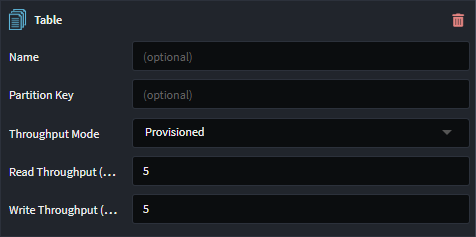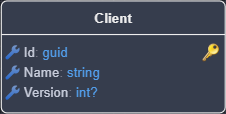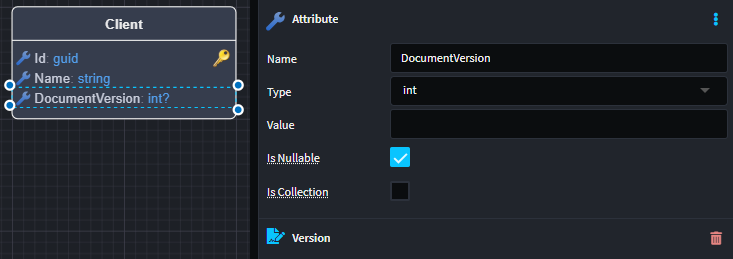Intent.Aws.DynamoDB
This module provides patterns for working with Amazon DynamoDB.
What is DynamoDB?
Amazon DynamoDB is a serverless, NoSQL database service that allows you to develop modern applications at any scale.
For more information on DynamoDB, check out their official docs.
What's in this module?
This module consumes your Domain Model, which you build in the Domain Designer and generates the corresponding DynamoDB implementation:
- Unit of Work and associated artifacts.
- DynamoDB Documents and associated artifacts.
- Repositories and associated artifacts.
appsettings.jsonconfiguration.- Dependency Injection wiring.
These DynamoDB patterns are realized mostly using the DynamoDBContext class from the .NET object persistence model.
Developing and testing with a local DynamoDB emulator
Amazon provides NoSQL Workbench for DynamoDB which includes a DynamoDB emulator you can run on your own machine for development and testing purposes.
By default this module adds the AWS:DynamoDB:UseLocalEmulator with a value of true to the generated appsettings.json:
"AWS": {
"DynamoDB": {
"UseLocalEmulator": true
}
}
When deploying your application to production this setting key will need to be removed or set to false. For more information on customizing configuration settings in production, refer to Microsoft's Configuration in ASP.NET Core article.
Domain Designer
When designing domain models for DynamoDB your domain package must be annotated with the Document Database stereotype. If you have multiple Document DB technologies modules, you must explicitly indicate which Domain Packages contain DynamoDB domain models, by setting Document Database's Provider property to DynamoDB.

Configuring Tables
A Table Stereotype can be applied to Classes, Folders and Domain Packages to control the DynamoDB table to be used for particular entities.


To determine the Table settings for a particular Class, the elements are checked in the following priority for the presence of Table stereotype: the Class itself, then any parent folders from most deeply to less deeply nested for the class, and then finally the Domain Package itself.
Name
The optional Name property controls the name for the table.
If it has a blank value on a Class or any of its ancestor elements or the package, then it uses the pluralized and kebab cased version of the class name.
Partition Key
The optional Partition Key property controls the partition key for the table.
If it has a blank value on a Class or any of its ancestor elements or the package, then it will use the name of the on the attribute on the same class with the Primary Key stereotype applied to it and the default name for these attributes is id.
Throughput
The Throughput Mode property controls the throughput capacity for the table.
On-demand
When On-demand is selected for the Throughput Mode property the Maximum Read Throughput (Units) and Maximum Write Throughput (Units) values can be specified.
Provisioned
When Provisioned is selected for the Throughput Mode property the Read Throughput (Units) and Write Throughput (Units) values can be specified.
Optimistic Concurrency
Optimistic concurrency in DynamoDB uses a Version attribute to manage concurrent updates, ensuring that updates only succeed if the Version in the update request matches the current Version of the item in the database. This prevents overwriting changes made by other transactions, maintaining data consistency without locking resources.
You opt into optimistic concurrency through the Use Optimistic Concurrency setting, which is on by default.
The patterns in this module support this in 2 ways
- Implicit optimistic concurrency
- Explicit optimistic concurrency
Implicit optimistic concurrency
The repositories will track the Version of all read documents and ensure that any writes to the DB use the Version which was read, ensure the documents have not been changed between you reading them and writing back to them, with a single service call.
Explicit optimistic concurrency
In this scenario you can explicitly model an Version attribute of type nullable int? on your domain entity. e.g.:

If you want the attribute to have a name other than Version give the attribute any name you want and then apply the Version stereotype:

Related Modules
Intent.Metadata.DocumentDB
This modules provides Document DB related stereotypes for extending the Domain Designer with Document DB technology specific data.
Intent.Entities
This module generates domain entities as C# classes, which are used by this model.